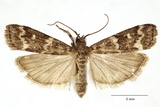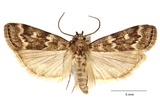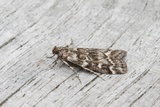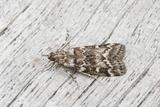Dioryctria schuetzeella Fuchs, 1899 Species
Last modified: Nov. 21, 2025, 1:55 p.m.
A widespread, but local and rather rare species in Belgium.
Details
- Classification
- Family: Pyralidae > Subfamily: Phycitinae > Tribus: Phycitini > Genus: Dioryctria > Species: Dioryctria schuetzeella
- Vernacular names
- Sparrenscheutboorder (NL), Fichten-Harzzünsler (DE)
- First mention in Belgium
- Janmoulle E. 1946b. Microlépidoptères nouveaux pour la faune belge. — Lambillionea 46: 121–123. On page 121.
- Status
-
Native
Distribution
Imago
Wingspan c. 24 mm. It is generally the smaller of the Belgian Dioryctria species and is often a brighter looking moth showing broader white bands. It has two light spots on the light gray hindwings (but this is not visible in the field), the other native Dioryctria species do not have these bright spots.
The inner transverse line runs clearly in a zigzag. Both transverse lines, inner and outer, are clearly marked in white on the opposite sides. The rusty brown spot on the wing, if present at all, is tinted olive.
Bionomics
The larva lives in a spinning amongst the needles.The adults come to light.
Flight periods
The adults have been observed from late May till mid-September.
Observed on
- Host plant (species):
- Picea abies
The larvae live between needles of Picea abies spun together.





